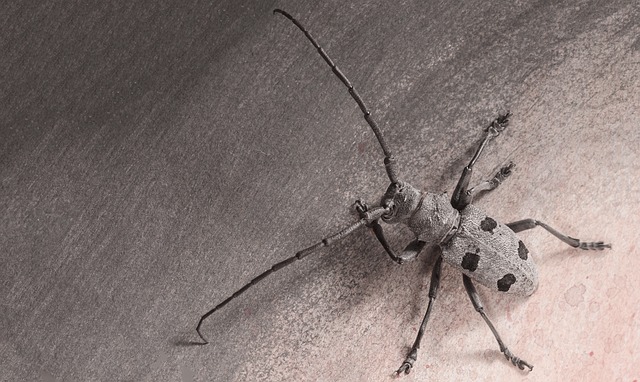Dead wood is rich in sugars and can serve as an energy source when digested, but it lacks other nutrients, preventing the growth, development, and maturation of saproxylophages. Prokaryotic N fixation partially mitigates the limitations on saproxylophages by the scarcity of N, often the most limiting nutrient, what does not mitigate co-limitation by other physiologically essential nutrients. Fungal transport can shape nutrient dynamics early in wood decay, rearranging extremely scarce nutritional composition of dead wood environment during its initial stage of decomposition and assisting saproxylophage growth and development. This nutritional enrichment of dead wood creates a nutritional niche for xylophages that allows them to grow, develop, and reach maturity. Therefore, xylophagous insects (considered as “wood-eaters”) are unable to gather the necessary amounts of nutritional elements from pure dead wood to grow and mature, but instead must utilize fungal tissues.
- beetle
- dead wood
- deadwood
- decay
- decomposition
- ecological stoichiometry
- ecosystem ecology
- ecosystem engineer
- fungi
- longhorn beetle
- nutrient flow
- nutrient limitation
- nutritional ecology
- trophic link
- wood
- wood boring
- wood-boring
- woodboring
- xylophage
- insect
1. Nutritional Quality Matters
One of the most direct and powerful factors influencing the decomposition of difficult-to-digest matter is the nutritional quality of the matter [1][2][3][4][5]. Nutritional quality is understood as the availability of physiologically important nutrients, which are needed to maintain and develop the bodies of decomposers, and the availability of the energy needed to perform any action. Therefore, one thing is certain: matter may be hard to decompose if it is rich in nutrients but the nutrients are immobilized in difficult-to-digest polymers. However, regardless of digestibility, the matter may be hard to decompose if it is low in nutrients because a molecule, even if it is easy to digest and assimilate, must be a source of nutrients needed by a consumer to be a food source for the consumer. Wood, especially dead wood, is both difficult-to-digest and extremely low in nutrients [6].
2. Wood is Extremely Nutrient-Poor
The natural polymers that compose wood, such as lignin, cellulose and hemicelluloses, must be first degraded by exoenzymes. Then, the simpler molecules resulting from the degradation may be ingested by decomposer organisms, providing them with energy[1]. The crucial ecological characteristics that impact the process of natural polymer degradation are the community structure of decomposer organisms, its functional complexity and its dynamics[4][7][8][9][10][11][12][13]. Some microorganisms are able to assimilate nitrogen (N) directly from the air and even provide it to their hosts (insects)[14][15]. However, according to the law of conservation of mass, the other (than N) atoms that compose the organisms’ bodies cannot be created out of nothing[16]. Wood is composed almost exclusively of carbon (C), hydrogen (H) and oxygen (O) [16]. During the digestion of C, H and O compounds, it is possible for organisms to acquire energy and some of the C, H and O needed to form new cells, hyphae or tissues. Therefore, what sources might wood-digesting organisms use to acquire atoms of all 25 elements that compose the molecules that form their body tissues as well as other elements that are physiologically active in ionic form? In other words, where do all the P, K, Na, Mg, Ca, Fe, Zn, Cu and other physiologically essential elements that are needed to compose, e.g., RNA, enzymes, phospholipids, proteins, nucleic acids or ATP, come from? Fungi may be the answer.
Fungi play an important role in the early stage of decomposition since they produce polymer-degrading exoenzymes that are necessary to start the decomposition process[9][12]. However, this is not the only factor that makes fungi important players in initiating and accelerating decomposition. Although wood is rich in sugars and can serve as an energy source when digested, it lacks other nutrients, preventing the growth and development of decomposer individuals and communities. However, this hindrance does not concern fungi, which are able to develop a network of connections between nutritionally rich and scarce patches inside ecosystems, mobilize nutrients from these patches and translocate them inside developed mycelial networks[4][17][18][19][20][21][22][23][24][25]. Therefore, is it possible that xylophagous organisms (and no, we are not talking about bark beetles), i.e., “wood eaters”, are in fact fungivores?
3. Nutritional Needs of Wood-Eating Insects
The chemical composition of consumers differs from that of their food, which imposes limitations on consumers’ growth and development[26][27]. This concerns not only the organic chemistry of life but, in particular, atoms of chemical elements that are the basic building blocks that compose all living matter, from bacteria to whales. It is impossible to understand the nutritional constraints of growing and developing organisms, colonies and populations without reference to these elements. Molecules, cells, tissues, organisms and populations, despite their diversity and complexity, are all built of atoms of approximately 25 elements and are completed and maintained via the use of energy[26][27][28][29]. Moreover, they are composed of specific sets of atoms selected from the environment in proportions required to create organic molecules that form the bodies of the organisms; these species-specific proportions are called the stoichiometric phenotype. Since the bodies of organisms are built according to specific “elemental recipes”, they must maintain elemental “stoichiometric” homeostasis. Therefore, the active regulation of elemental body stoichiometry (proportions of atoms) is an essential trait of individuals[27][29]. Taking this into account, the law of conservation of mass states that all the atoms of the 25 elements that compose all living things cannot be created out of nothing.
Sterner and Elser[27] comprehensively discussed the nutritional needs of organisms in terms of C:N:P stoichiometry. Atoms of more than just those three extensively studied elements are needed to compose the cells and bodies of organisms[26][28]. The question arises: What are the nutritional requirements of organisms that can feed on dead wood, and how are these requirements related to the nutritional composition of wood? To answer this question, the elemental composition and stoichiometry of wood-boring beetles (xylophages) were compared with the composition of pure dead wood and of dead wood overgrown with fungi to various degrees[16]. It was shown[16] that the life cycles of “wood-eating” beetles are shaped by the importation of N, P, K, Na, Mg, Zn, and Cu by fungi into nutritionally barren dead wood at the start of the decay process. The strategy used by saproxylophages to overcome the nutritional limitations of dead wood involves (1) fungal rearrangements of dead wood stoichiometry during the first years of decay and (2) prolonged growth supported by a low mortality risk. The nutritional quality of dead wood changes over the first several years of decomposition, and this is important to the first species of saproxylophagous insects that colonize a dead piece of wood. However, the other species that colonize dead wood after this initial stage of decomposition also rely on the nutritional rearrangement of the wood that occurs over the first several years of decomposition.
Xylophagous (wood-eating) beetles do not use wood as a source of the nutrients needed to build and maintain the growing bodies of the beetles
Pure dead wood is too nutritionally poor to be a sufficient source of food for saproxylophagous insects [16]. The nutrients required for insects to properly develop are transported to dead wood by fungi, resulting in a rearrangement of the nutritional composition of the wood during the first few years of decay [16]. Fungal hyphae in dead wood are connected to nutritional patches of organic matter or to minerals in the external environment. Rocks can be weathered by fungi and are sources of the specific atoms used to build fungal mycelia, and these atoms are further translocated within the ecosystem. Fungi can consume soil fauna and exchange the acquired nutrients for C from trees; the acquired nutrients are then translocated to the dead wood through the fungal mycelium. Depending on the size of the adult, saproxylophages can grow, develop, and reach maturity by consuming wood rich in fungal hyphae over the course of several years. During this period, they are able to gather all the building blocks (atoms) required to develop their adult bodies. This prolonged developmental time is feasible because the interior of the dead wood is a safe environment that provides favourable climatic conditions, thereby reducing their mortality compared with that of insects in the surrounding environment.
The application of ecological stoichiometry to the nutrient dynamics of dead wood has led to the following conclusions [16]:
- The growth and development of dead-wood-eating beetles is co-limited by the scarcity of essential elements, such as N, P, K, Na, Mg, Zn, and Cu.
- Fungi use dead wood as a source of energy and rearrange it nutritionally while growing in dead wood during the first 4–5 years of decay. Thus, fungi can fill a nutritional niche for dead wood eaters that facilitates insect growth, development, and maturation.
- In turn, xylophages affect dead wood by fragmenting, shredding, and producing frass, thereby contributing to further wood decomposition and nutrient cycling.
- Because of the complex ecological interactions among dead wood, fungi, and dead wood eaters, large masses of organic matter in terrestrial ecosystems (wood) are continuously being decomposed in forests. Much remains to be learned about the multielemental co-limitation of saproxylophagous insect growth and development and its role in shaping wood decomposition and nutrient cycling in ecosystems.
References
- Marie-Madeleine Couˆteaux; Pierre Bottner; Björn Berg; Litter decomposition, climate and liter quality. Trends in Ecology & Evolution 1995, 10, 63-66, 10.1016/s0169-5347(00)88978-8.
- Cindy Prescott; Litter decomposition: what controls it and how can we alter it to sequester more carbon in forest soils?. Biogeochemistry 2010, 101, 133-149, 10.1007/s10533-010-9439-0.
- Berg, B; McClaugherty, C. Plant Litter; 3rd ed; Springer-Verlag: Berlin Heidelberg, 2014; pp. ISBN 978-3-642-38820-0.
- Swift, M.J.; Heal, O.W.; Anderson, J.M. Decomposition in Terrestrial Ecosystems; University of California Press: Berkeley and Los Angeles, 1979
- M.E. Harmon; J.F. Franklin; F.J. Swanson; P. Sollins; S.V. Gregory; J.D. Lattin; N.H. Anderson; S.P. Cline; N.G. Aumen; J.R. Sedell; et al.G.W. LienkaemperK. CromackK.W. Cummins Ecology of Coarse Woody Debris in Temperate Ecosystems. Advances in Ecological Research 1986, 15, 133-302, 10.1016/s0065-2504(08)60121-x.
- Michał Filipiak; A Better Understanding of Bee Nutritional Ecology Is Needed to Optimize Conservation Strategies for Wild Bees—The Application of Ecological Stoichiometry. Insects 2018, 9, 85, 10.3390/insects9030085.
- Stephan Hättenschwiler; Nathalie Fromin; Sandra Barantal; Functional diversity of terrestrial microbial decomposers and their substrates. Comptes Rendus Biologies 2011, 334, 393-402, 10.1016/j.crvi.2011.03.001.
- Sara Foudyl-Bey; Suzanne Brais; Pascal Drouin; Litter heterogeneity modulates fungal activity, C mineralization and N retention in the boreal forest floor. Soil Biology and Biochemistry 2016, 100, 264-275, 10.1016/j.soilbio.2016.06.017.
- Chapin III, F.S.; Matson, P.A.; Mooney, H.A. Terrestrial Decomposition. In Principles of Terrestrial Ecosystem Ecology; Springer-Verlag: New York, 2002; pp. 151–175
- Christina Kaiser; Oskar Franklin; Ulf Dieckmann; Andreas Richter; Microbial community dynamics alleviate stoichiometric constraints during litter decay. Ecology Letters 2014, 17, 680-690, 10.1111/ele.12269.
- Jana Voriskova; Petr Baldrián; Fungal community on decomposing leaf litter undergoes rapid successional changes. The ISME Journal 2012, 7, 477-486, 10.1038/ismej.2012.116.
- Thomas Schneider; Katharina Keiblinger; Emanuel Schmid; Katja Sterflinger-Gleixner; Günther Ellersdorfer; Bernd Roschitzki; Andreas Richter; Leo Eberl; Sophie Zechmeister-Boltenstern; Katharina Riedel; et al. Who is who in litter decomposition? Metaproteomics reveals major microbial players and their biogeochemical functions. The ISME Journal 2012, 6, 1749-62, 10.1038/ismej.2012.11.
- Ng Liu; Katharina Keiblinger; Sonja Leitner; Axel Mentler; Sophie Zechmeister-Boltenstern; Is there a convergence of deciduous leaf litter stoichiometry, biochemistry and microbial population during decay?. Geoderma 2016, 272, 93-100, 10.1016/j.geoderma.2016.03.005.
- Focht, D.D. Advances in Microbial Ecology; Marshall, K.C., Ed.; Springer US: Boston, MA, 1982; Vol. 134; ISBN 9781468476118
- A. E. Douglas; The microbial dimension in insect nutritional ecology. Functional Ecology 2009, 23, 38-47, 10.1111/j.1365-2435.2008.01442.x.
- Michał Filipiak; Nutrient Dynamics in Decomposing Dead Wood in the Context of Wood Eater Requirements: The Ecological Stoichiometry of Saproxylophagous Insects. Saproxylic Insects 2018, 1, 429-469, 10.1007/978-3-319-75937-1_13.
- N. Stark; Nutrient Cycling Pathways and Litter Fungi. BioScience 1972, 22, 355-360, 10.2307/1296341.
- D.J. Lodge; Nutrient concentrations, percentage moisture and density of field-collected fungal mycelia. Soil Biology and Biochemistry 1987, 19, 727-733, 10.1016/0038-0717(87)90055-1.
- Lynne Boddy; Sarah C. Watkinson; Wood decomposition, higher fungi, and their role in nutrient redistribution. Canadian Journal of Botany 1995, 73, 1377-1383, 10.1139/b95-400.
- Dighton, J. Fungi in Ecosystem Processes; Dighton, J., Ed.; CRC Press: New York, 2003; ISBN 978-0-8247-4244-7
- Dighton, J. Nutrient Cycling by Saprotrophic Fungi in Terrestrial Habitats. In Environmental and Microbial Relationships; Kubicek, C.P., Druzhinina, I.S., Eds.; Springer Berlin Heidelberg, 2007; pp. 287–300 ISBN 978-3-540-71840-6
- J. W. G. Cairney; Basidiomycete mycelia in forest soils: dimensions, dynamics and roles in nutrient distribution. Mycological Research 2005, 109, 7-20, 10.1017/s0953756204001753.
- Watkinson, S.C.; Bebber, D.; Darrah, P.; Fricker, M.; Tlalka, M.; Boddy, L. The role of wood decay fungi in the carbon and nitrogen dynamics of the forest floor. In Fungi in Biogeochemical Cycles; Gadd, G.M., Ed.; Cambridge University Press: Cambridge, 2006; pp. 151–181 ISBN 0521845793
- Peter Clinton; P. K. Buchanan; J. P. Wilkie; Simeon J. Smaill; M. O. Kimberley; Decomposition of Nothofagus wood in vitro and nutrient mobilization by fungi. Canadian Journal of Forest Research 2009, 39, 2193-2202, 10.1139/x09-134.
- Maria Mooshammer; Wolfgang Wanek; Sophie Zechmeister-Boltenstern; Andreas Richter; Stoichiometric imbalances between terrestrial decomposer communities and their resources: mechanisms and implications of microbial adaptations to their resources. Frontiers in Microbiology 2014, 5, na, 10.3389/fmicb.2014.00022.
- Fraústo da Silva, J.J.R.; Williams, R.J.P. The biological chemistry of the elements. The inorganic chemistry of life; 2nd ed.; Oxford University Press, 2001
- Sterner, R.W.; Elser, J.J. Ecological Stoichiometry: The Biology of Elements from Molecules to the Biosphere; Princeton University Press: Princeton, NJ, 2002; ISBN 0691074917
- Michael Kaspari; Jennifer S. Powers; Marlene Zuk; Biogeochemistry and Geographical Ecology: Embracing All Twenty-Five Elements Required to Build Organisms. The American Naturalist 2016, 188, S62-S73, 10.1086/687576.
- Puni Jeyasingh; Jared M. Goos; Seth Thompson; Casey M. Godwin; James Bryan Cotner; Ecological Stoichiometry beyond Redfield: An Ionomic Perspective on Elemental Homeostasis. Frontiers in Microbiology 2017, 8, 884, 10.3389/fmicb.2017.00722.




